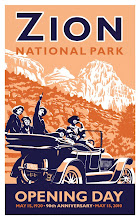 One of the best things about this book experience for me has been coming to know the six girls who took this trip to Zion. All of them were full of personality. John and I wish that we could have had the opportunity to meet all of them in person. There was not a boring one in the lot. In the next several posts, I will spend time sharing some of the things that we have learned about each of these remarkable women.
One of the best things about this book experience for me has been coming to know the six girls who took this trip to Zion. All of them were full of personality. John and I wish that we could have had the opportunity to meet all of them in person. There was not a boring one in the lot. In the next several posts, I will spend time sharing some of the things that we have learned about each of these remarkable women.I will start with Anna Gaarden Widtsoe. She was the daughter of John A. Widtsoe, who was President of the University of Utah at the time of the trip to Zion. In a lot of ways, we know the most about Anne because she gave many of her scrapbooks and journals to the Utah State Historical Society. That is where I started learning about her. I was sucked into her young life by her journals which were full of boys and social occasions. In an age where there still were not a huge amount of cars on the streets of Salt Lake City, she learned how to drive and take care of cars. She often was called upon to drive friends to and from parties up at the university. In her journal, she told about being pulled over one night for reckless driving, but the officer let her go once she told him who's daughter she was. Her driving antics continued into her later years, when in her fifties she was pulled over for singing and driving. (She was changing lanes at the beginning of each new verse. Anne was then arrested because she refused to tell the officer her age.) Anne loved to play practical jokes. Her daughter told us that she once gathered up a hand full of snakes and then released them in the middle of a school dance. It was from Anne's journal that we discovered all the pranks that were going on during that week in Zion that were not reported in the newspapers. She was very popular in school. A year after the Zion trip, Anne went on a mission for the Church of Jesus Christ of Latter-day Saints to the Southern States Mission for two years. Later, she married Lewis J. Wallace and had three children. Anne and Lewis later divorced, but she encouraged her children to continue to love and respect him. Anne believed in work. She worked as a librarian for the University of Utah for twenty-seven years and spent countless hours in volunteer work even into her nineties. I received the impression that Anne was not one for standing still. She had a reputation as the ultimate party giver of her time. She once said, "If I am going to get old, I might just as well get as old as I can.", and Anne did a pretty good job of that, too. She was 91 years old when she died.









